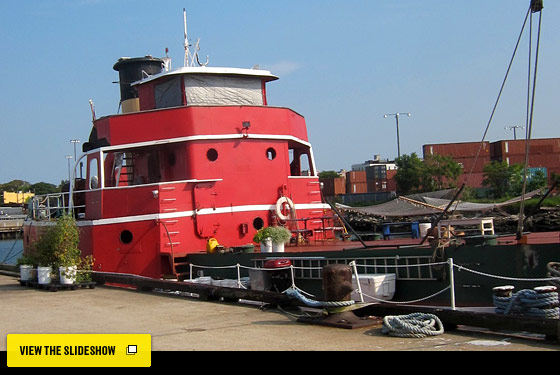

PortSide New York (portsidenewyork.org), a nonprofit organization founded in 2005 by Carolina Salguero, is dedicated to improving New Yorkers’ understanding of our bluespace, i.e., the aquatic part of the city. Fittingly, PortSide’s offices are onboard a retired oil tanker, the Mary A. Whalen, docked on the south side of Pier 9B in the Red Hook Container Port. PortSide was chosen by DesigNYC as a 2011 design collaboration project, pairing it with pro bono architects 590 BC and Studio L’Image to help restore the boathouse/community center. Carolina and volunteer crew member John Weaver were kind enough to give me a tour. Photo: Wendy Goodman

Here, a deck’s-eye view. Looking toward the stern, left, you can see the wheelhouse on the very top, and a number of portholes in the captain’s and crew’s cabins below. The hammocks and table have been added for visitors to enjoy during tours and performances. Photo: Wendy Goodman

The ship’s captain had the deserved luxury of his own cabin and bathroom (or in seaman’s parlance, the head). Considering the setting, this is pretty spacious. Photo: Wendy Goodman

The term “ship shape” comes to mind when you see how perfectly everything was built to fit the small spaces of the tanker. The captain’s desk is surrounded by portholes for lots of natural light. Photo: Wendy Goodman

The doors to the captain’s lockers are meticulously finished and the brass fixtures are all original. I love those graceful little egg-shaped doorknobs. Photo: Wendy Goodman

John’s father-in-law captained the Mary Whalen for twenty years and spent many harrowing nights maneuvering this wheel. John was told by one crew member that during a particularly violent storm, the captain did not take his hands off it for eight straight hours. Photo: Wendy Goodman

The ship’s compass in front of the steering wheel is anchored by those two round weights, which help correct the magnetic pull of the ship’s own metals and any inherent errors in the compass itself. Photo: Wendy Goodman

The wheelhouse’s acoustic tile walls made it easy to post news. Photo: Wendy Goodman

The “speaking tube” in the wheelhouse, used by the engineer to give orders to the crew below deck. Photo: Wendy Goodman

How beautiful is this? I spied a weathered tabletop outside the wheelhouse with the texture and patina of the eyes in a peacock feather. Photo: Wendy Goodman

Down below deck, the crew’s quarters. The cabins are now used as offices for PortSide volunteers; the entrance to the galley, seen here, is still used for meals and meetings. Photo: Wendy Goodman

Every single object in the galley has to be solid as a rock and stable for the worst sea conditions imaginable. The metal countertop has a lip so nothing can slide off and the drawers and storage cabinets are made of solid metal. Photo: Wendy Goodman

The original round table and circular stools are bolted into the tiled floor and weigh a ton. Photo: Wendy Goodman

Carolina pointed out that the galley stove is “Webb Perfection,” a longtime staple on workboats. “Our model was patented in 1918 and we still get service out of it!” The company that made it, Elisha Webb & Son, is still in business today (www.elishawebb.com). Photo: Wendy Goodman

How about the handsome fridge/freezer in the galley! This is probably not the original, Carolina says, but it’s pretty great looking all the same. Photo: Wendy Goodman

Carolina rescued this kitten, Mighty Moe, from an abandoned litter in one of the neighboring warehouses. He is only a couple of days old. Photo: Wendy Goodman

As you can see, Carolina is used to multitasking. Before founding PortSide New York, she traveled the world as a freelance writer and photographer. In 2002, she completed a two-and-a-half year project on New York City’s tugboats for National Geographic, which led to her work on the ports today. At the writing of this, Mighty Moe had gained an ounce and was doing very well. Photo: Wendy Goodman

